Staff Maintenance
Usage
This screen is for staff member details including adding new users to the system and assigning their contracts, units, leaves, events, skills, training and expenses.

Staff Search Options
Click the cog icon to the right of the search field to display search options.
 Current staff (default): Shows all staff who
aren't leavers.
Current staff (default): Shows all staff who
aren't leavers.
Leavers (terminated): Shows only leavers (indicated by putting a date in the termination field in
Staff maintenance).
Exclude staff with no current contract:
Do not show staff who do not have a current contract but who are not leavers.
Once options have been set,
simply type the name of the staff member you wish to search
for in the search field.

Staff.Care's syntax is Staff Code: First name Surname and Staff.Care auto complete function begins after 2 characters.
Creating new Staff Members (Workflows)
The new starter workflow is a 9 step process. During the workflow you can go back to previous steps by clicking BACK and move forward by clicking CONTINUE.
All data is temporarily held until the workflow is completed and any changes made will be reflected throughout the process.
To begin a New Starter Workflow > Click New.
The first page is demographics, fill in the fields as appropriate.
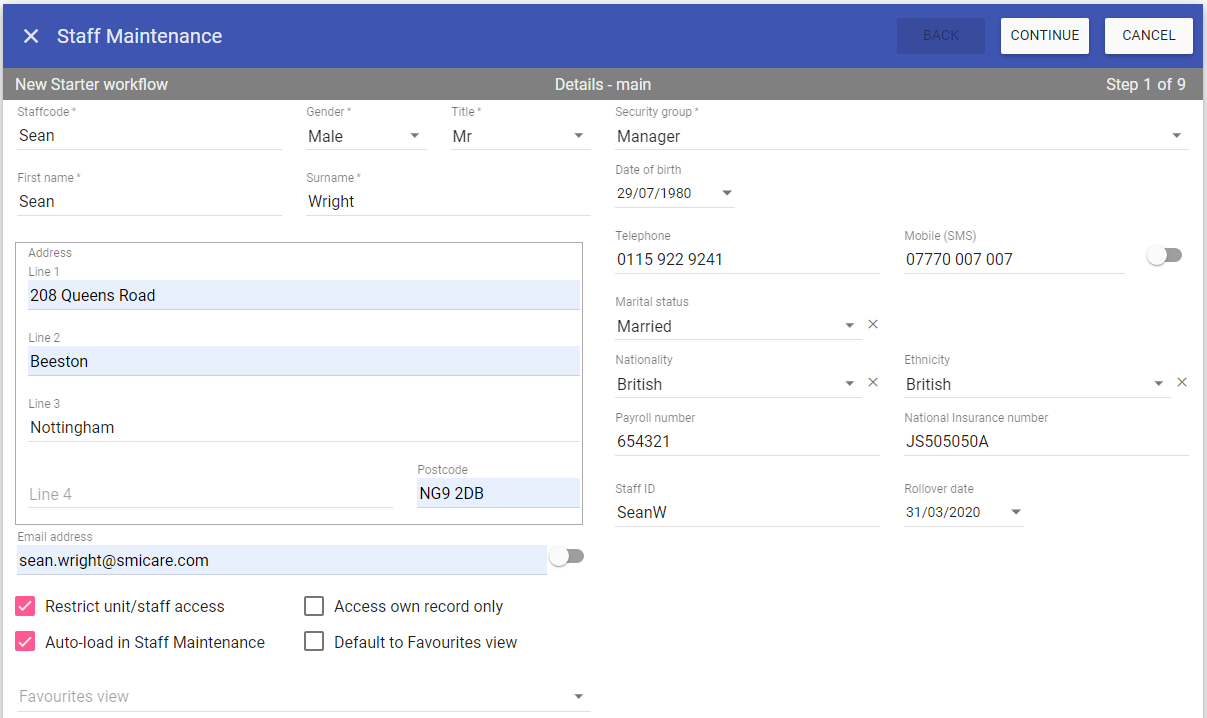 Staff Code: Is the unique identifier for the bank staff member set by the user.
Staff Code: Is the unique identifier for the bank staff member set by the user.
Gender: The gender of that member of staff e.g. male.
Title: The title of that member of staff e.g. MR or MRS.
Security group: The security group of that member of staff set up in Admin > Security Groups.
First name: The first name of that member of staff.
Surname: The surname of that member of staff.
Date of birth: The date of birth of that member of staff.
Address line 1: The address line 1 of that member of staff.
Address line 2: The address line 2 of that member of staff.
Address line 3: The address line 3 of that member of staff.
Address line 4: The address line 4 of that member of staff.
Postcode: The postcode of that member of staff.
Telephone: The telephone number of that member of staff.
Mobile (SMS): The mobile number of that member of staff.
Marital status: The marital status of that member of staff.
Nationality: The nationality of that member of staff.
Ethnicity: The ethnicity of that member of staff.
Payroll number: The payroll number for that member of staff.
National insurance number: The national insurance number of that member of staff.
Staff ID: This is a unique employee code for use outside Staff.Care.
Rollover date: The default date for the rollover of staff leaves.
Email address: Email address of that staff member.
Restrict unit/staff access: The user can only view staff details and unit details that they are assigned to.
Access own record only:
The user can only view their staff details but can view all available units.
Auto-load in staff maintenance: Loads the specific staff member upon clicking this menu without having to search.
Default to Favourites view: Use the favourites menu set up in Admin > Favourites.
Favourites view: Which favourites menu to use.
Step 2 is the next of kin details.
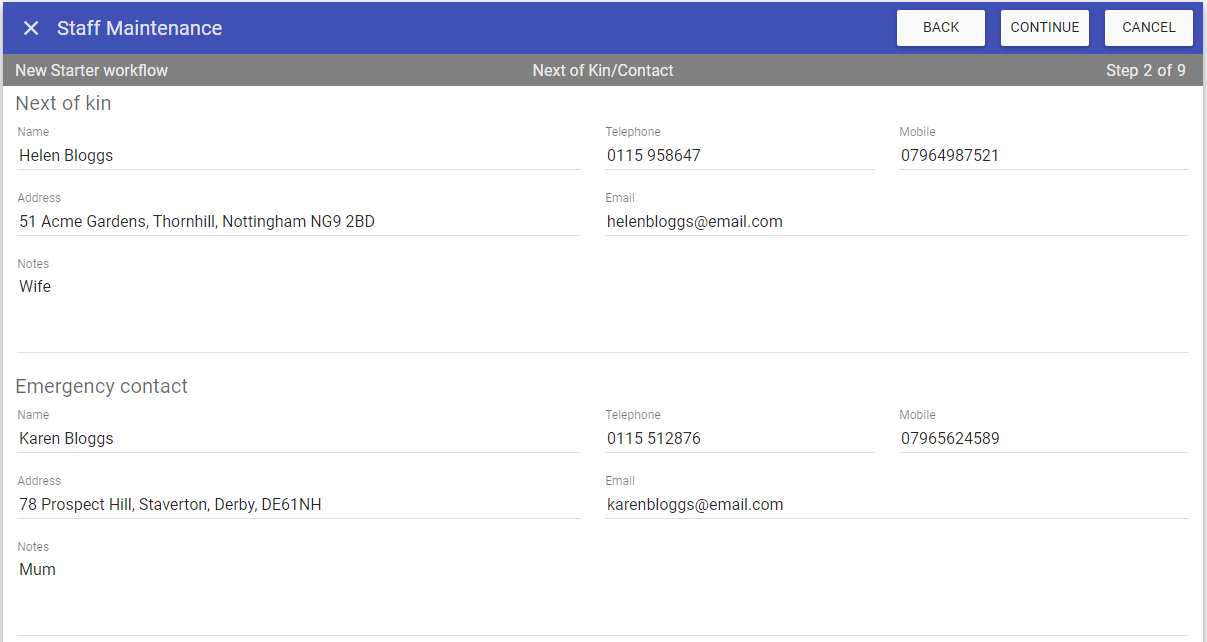 Next of kin
Next of kin
Name: The name of the next of kin.
Telephone: The telephone number of the next of kin.
Mobile: The mobile number of the next of kin.
Address: The address of the next of kin.
Email: The email address of the next of kin.
Notes: Additional information pertaining to the next of kin.
Emergency contact
Name: The name of the emergency contact.
Telephone: The telephone number of the emergency contact.
Mobile: The mobile number of the emergency contact.
Address: The address of the emergency contact.
Email: The email of the emergency contact.
Notes: Additional information pertaining to the emergency contact.
Step 3 is the payroll details.
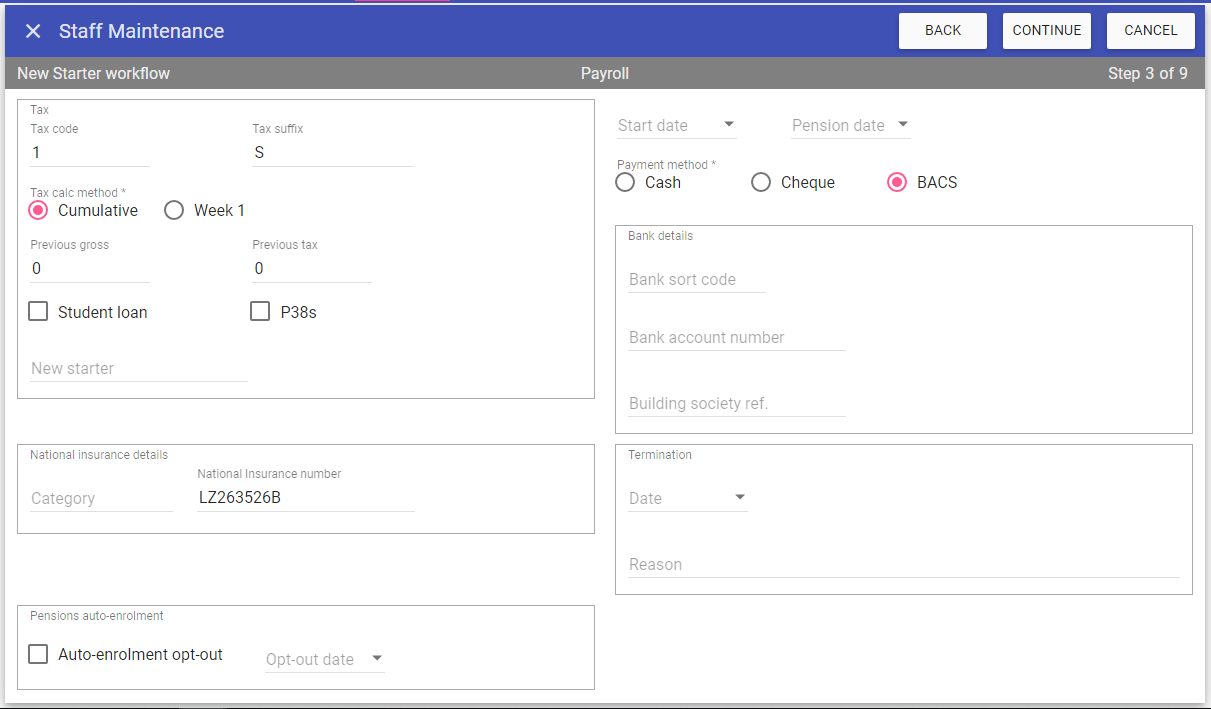 Tax code: Staff member tax code (numeric).
Tax code: Staff member tax code (numeric).
Tax suffix: Staff member tax code (alpha).
Cumulative: Annual tax allowance.
Week 1: i.e. emergency tax.
Previous gross: See P45.
Previous tax: See P45.
Student loan: Advised by inland revenue.
P38s: Advised by inland revenue.
New starter: Enter the new starter category (A, B or C) that applies to the new starter checklist.
Start date: When the staff member started working for the organisation.
Pension date: Date pension is due to start.
Cash: Paid in cash.
Cheque: Paid by cheque.
BACS: Paid by BACS.
Bank sort code: Bank sort code.
Bank account number: Bank account number.
Building society ref: Building Soc. Reference number.
Category: National insurance category.
National insurance number: National
insurance number.
Date: When the staff member does not work for the organisation anymore.
Reason: E.g. retired.
Auto-enrolment opt-out: Denotes if the staff member opted out of the
government auto-enrolment pension scheme.
Opt-out date: Date the staff member opted out of the
government auto-enrolment pension scheme.
Step 4 is the security details and is where you create the staff member logon to Staff.Care.
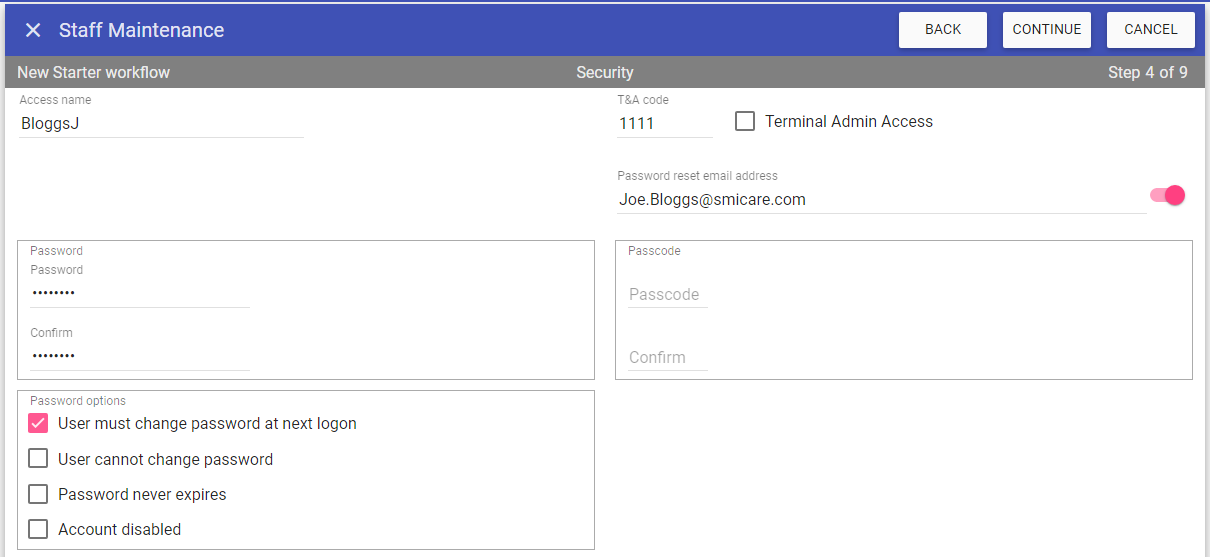 Access name: This is the user's login name.
Access name: This is the user's login name.
T&A code: This is a unique identifier for the user clocking-in (if biometric terminals are used)
Terminal Admin Access: This is ticked if user requires admin rights to the biometric terminal.
Password
Password: The user's password to login with.
Confirm: Confirmation of the user's password.
Password reset by email
Password reset email address: Enter an email address by which a password reset link will be sent if user locks themselves out of the system.
Allow password reset email: Upon entering an email address this defaults to on, if turned off this disables the password reset via email for this user.
Password options
User must change at next logon: Upon logging in the first time, the staff member must change the default password to one of their own choosing.
User cannot change password: Prevents the staff member from changing their own password.
Password never expires: Password
doesn't expire after the default expiry period.
Account disabled: User
name and password will no longer allow this staff member to login to Staff.Care.
Activating the Password reset email address: The toggle switch only becomes active once an email address is entered and both must be present for each staff member in order for them to be able to reset their own passwords.
REMEMBER: The reset email will be sent to the email address provided and the link will be active for a default of 20 minutes (this can be set anywhere from 10 minutes up to 720 minutes), please let SMI know how long you wish this to be prior to installation.
If you lock yourself out of Staff.Care you can reset your own password as follows:
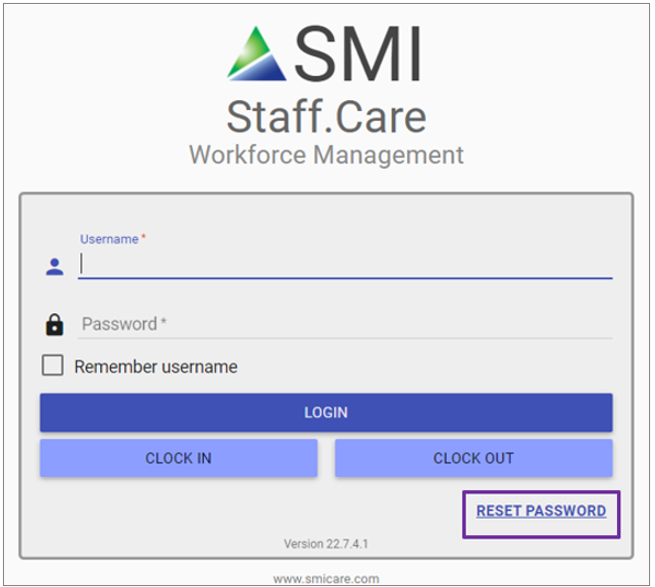
Upon clicking the RESET PASSWORD button you are prompted to enter your chosen reset email address and click on SEND EMAIL:
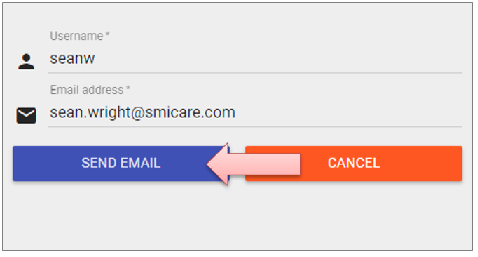
NOTE: If you enter the wrong email address the following will be displayed:
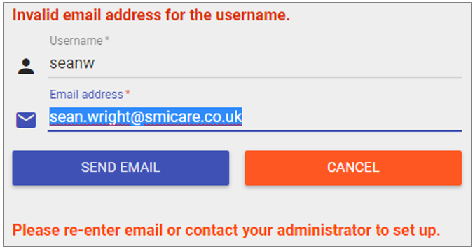
By entering your correct email address, you will receive an email with a link to reset your password:
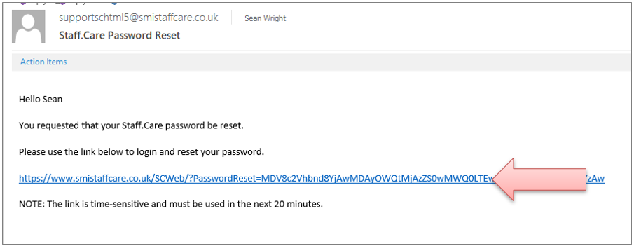
This will open a new window in your browser with your username already completed, simply enter a new password twice and click login:
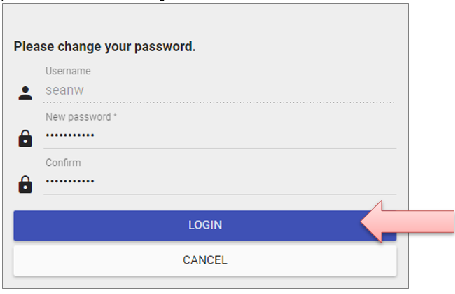
Step 5 is the Alert & Messaging screen where you can make your selections, example below shows alert groups assigned to managers,
however these Alert groups are not available to all staff members.
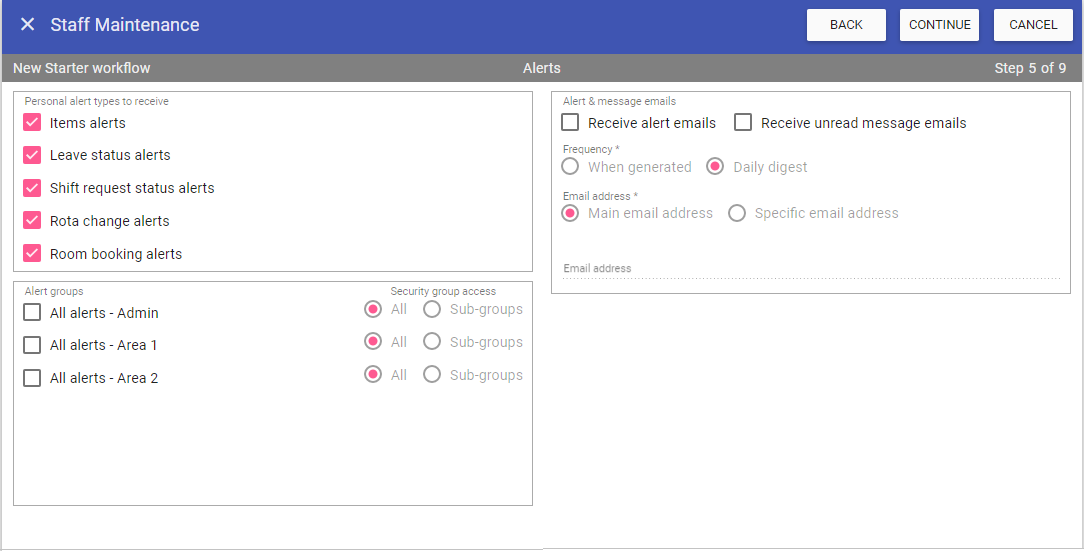 Personal Alerts: These should ALL be selected, denoting which personal alerts you receive.
Personal Alerts: These should ALL be selected, denoting which personal alerts you receive.
Alert Groups: These show you which groups you have access to, those ticked are the ones you will receive alerts for.
Security group access:
ALL: All staff security groups for that alert group.
Sub-groups: All staff security groups lower than yours for that alert group (useful for units with more than 1 manager and no team segregation).
Alert & Message emails:
Receive alert emails: This will email you any alerts you receive within Staff.Care.
Receive unread message emails: If selected, you will receive an email containing any unread messages within Staff.Care.
Frequency: As a manager, you should have this set to Daily digest, meaning you will only receive 1 email per day for alerts and unread messages.
Main email address: If selected, your emails for alerts and messages will be sent to the email address on the Details main page of your staff record.
Specific email address: If selected, you can enter any email address you wish to receive your alerts and messages in the Email address field.
Email Address: If main email address is chosen this will display the email address from your Details>Main screen and cannot be edited. If Specific email address is
chosen then you must enter the email address you wish to receive alert/messages emails.
NOTE: Your access to this screen depends on your system's chosen security settings, speak to your System Administration Team if any changes are required.
Step 6 is the start of the contract workflow.
Note: The following fields are all applied during leave accrual calculations setup in Admin >
Leave Accruals.
Job title, Start date, End date, Hours per week and Days off per week. (Job titles are used for WTE).
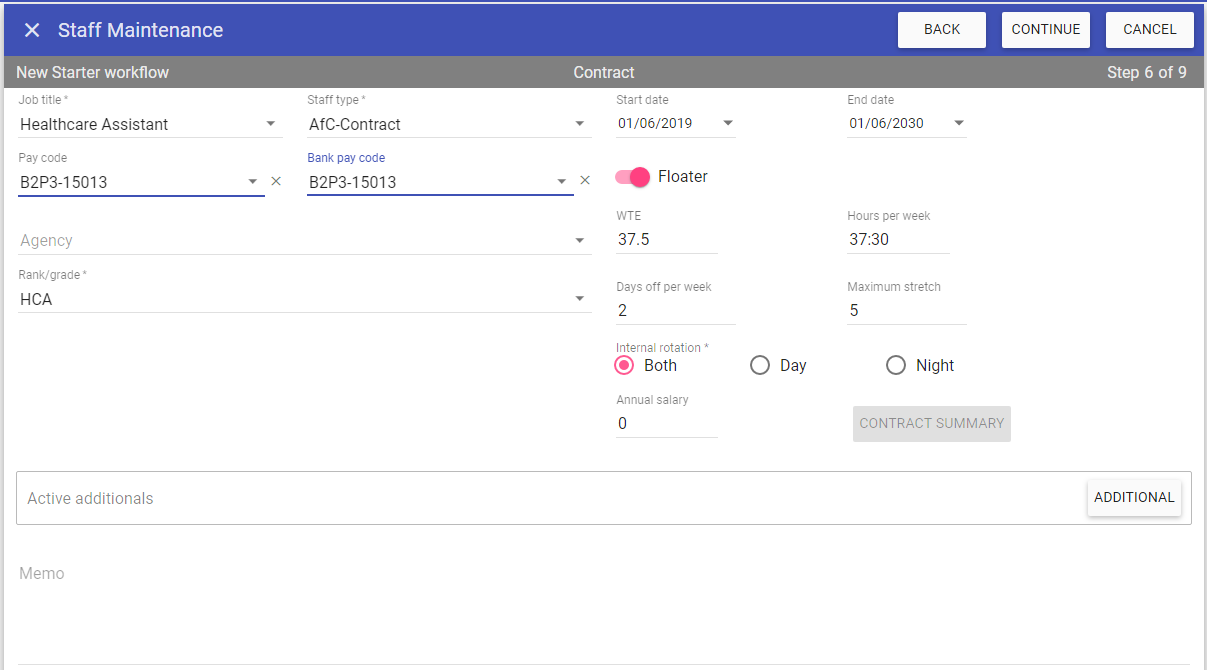 Contract The actual contract of the staff member.
Contract The actual contract of the staff member.
Start date: Staff member organisational contract start date.
End date: Staff member organisational contract end date.
Job title: The job title of the staff member.
Staff type: The staff type of the staff member.
Floater: Whether or not the staff member can work across different units.
Pay code: The pay code of the staff member.
Bank pay code: The pay code when working bank of the staff member.
WTE: Whole time equivalent hours.
Hours per week: The amount of hours per week the staff member works on this contract.
Agency: The agency that the staff member belongs to.
Days off per week: The amount of days the staff member
doesn't work on this contract.
Maximum stretch: The amount of consecutive days the staff member can work in a row.
Rank/grade: The rank and grade of the staff member.
Internal rotation
Both: Whether the staff member can work both day and night shifts.
Day: The staff member can work day shifts only.
Night: The staff member can work night shifts only.
Annual salary: The staff member's salary (yearly).
Contract summary: Used as a summary when contracts change.
Active additionals: Used to add additional grades and pay codes.
Memo: Any additional information about the staff member.
Step 7 is assigning the Staff member to Units, Work Patterns, Manage Teams and Default Rooms.
Simply click on the checkbox next to the units you wish to add, choose teams, pick which on you want to be primary and give access where required.
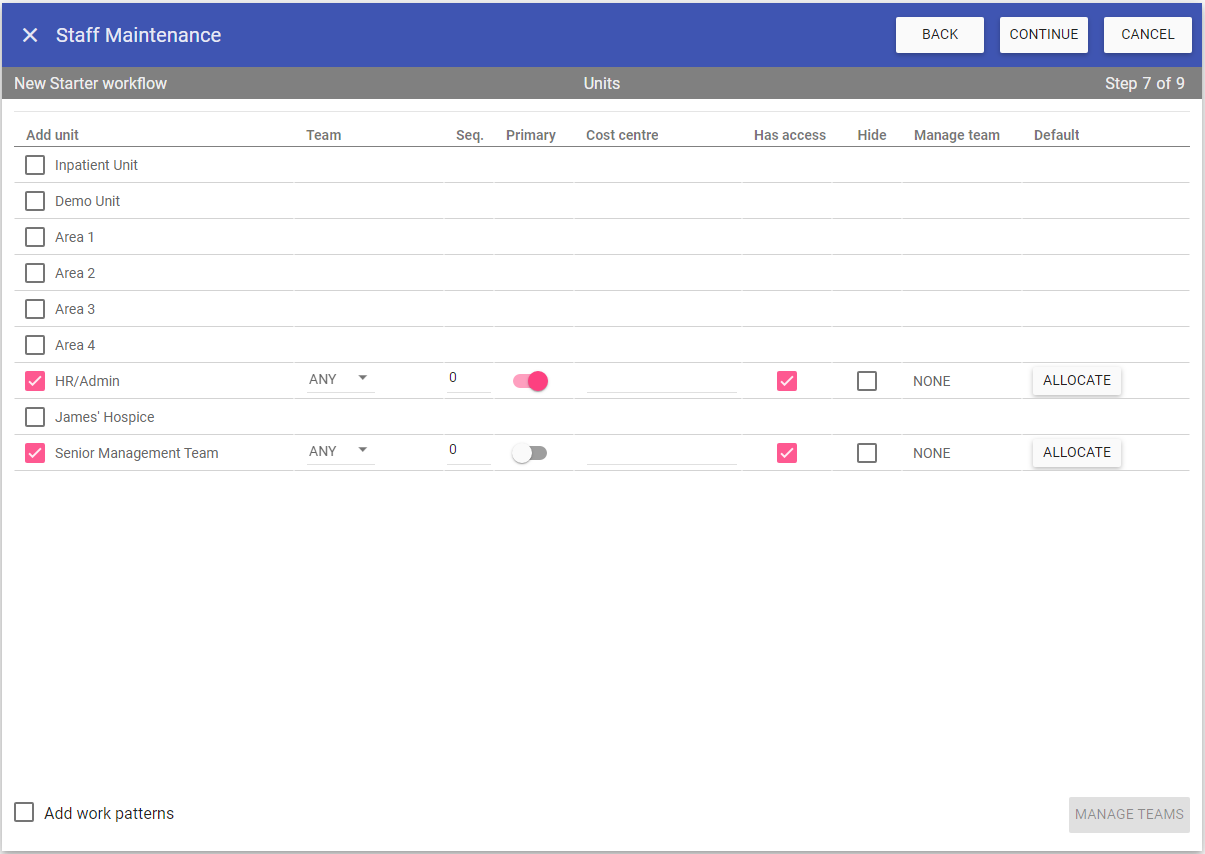 For higher grade staff that do not have access own record only checked there is the ability to restrict which staff they can access in Staff Maintenance through MANAGE TEAMS:
For higher grade staff that do not have access own record only checked there is the ability to restrict which staff they can access in Staff Maintenance through MANAGE TEAMS:
NOTE: ‘Manage teams’ limits access in Staff Maintenance only.
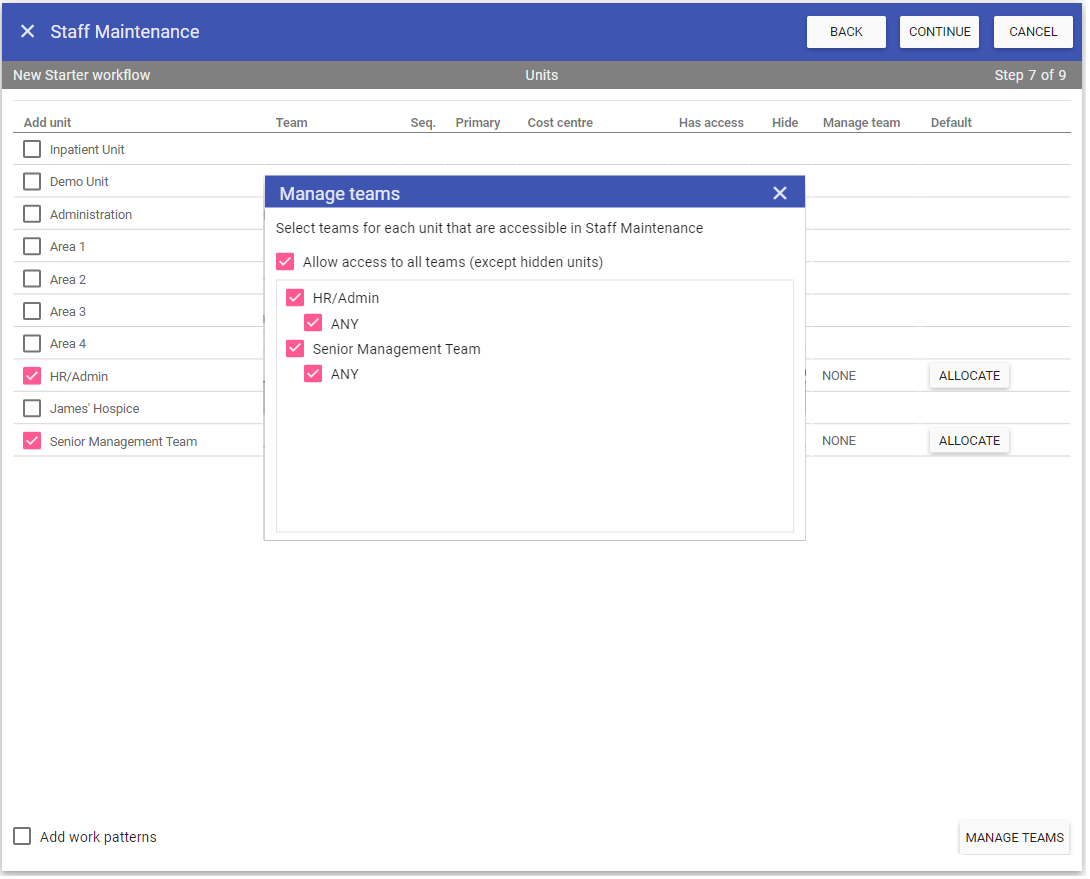
NOTE: If Work Patterns are selected whilst in this screen, the workflow changes from Step 7 of 9, to Step 7 to 10. Press Continue to complete the Work Patterns.
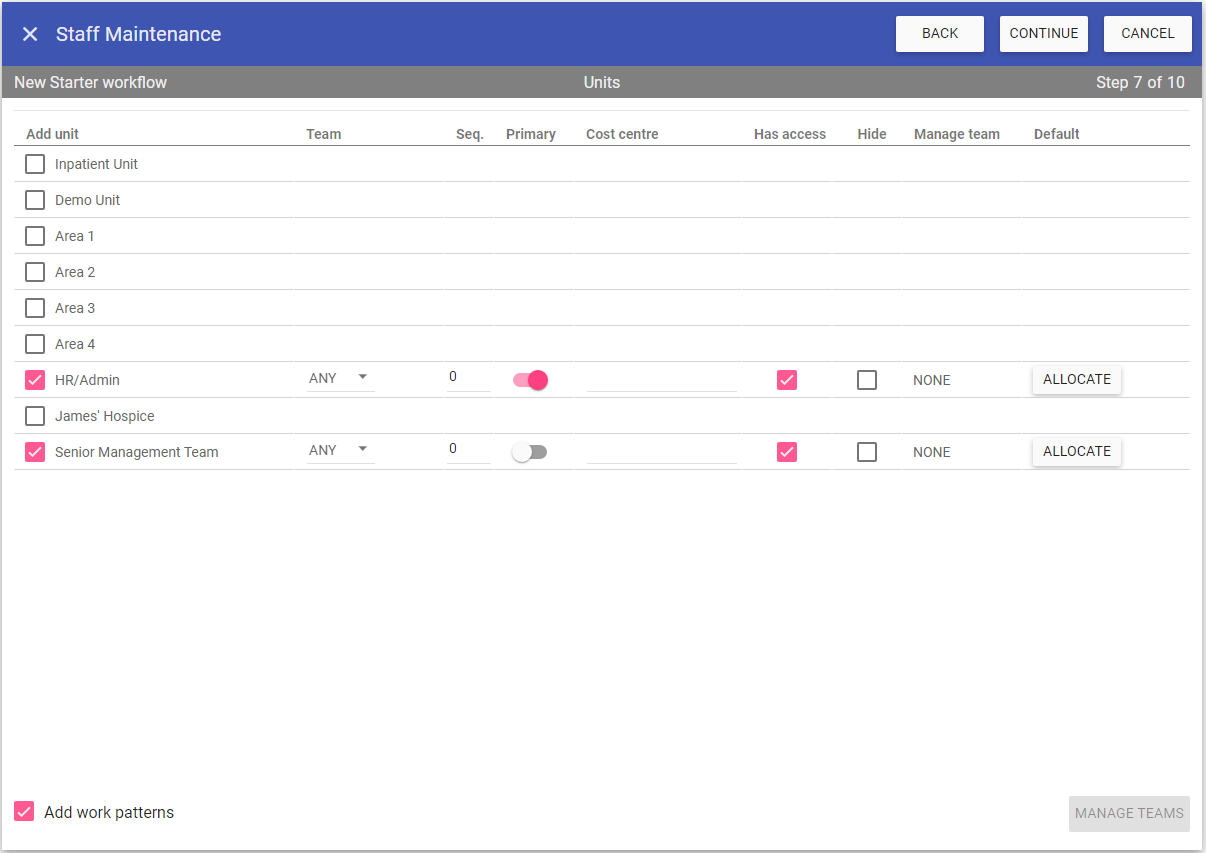 You also have the ability to default a room to a staff member simply by clicking on the Allocate button and selecting the room:
You also have the ability to default a room to a staff member simply by clicking on the Allocate button and selecting the room:
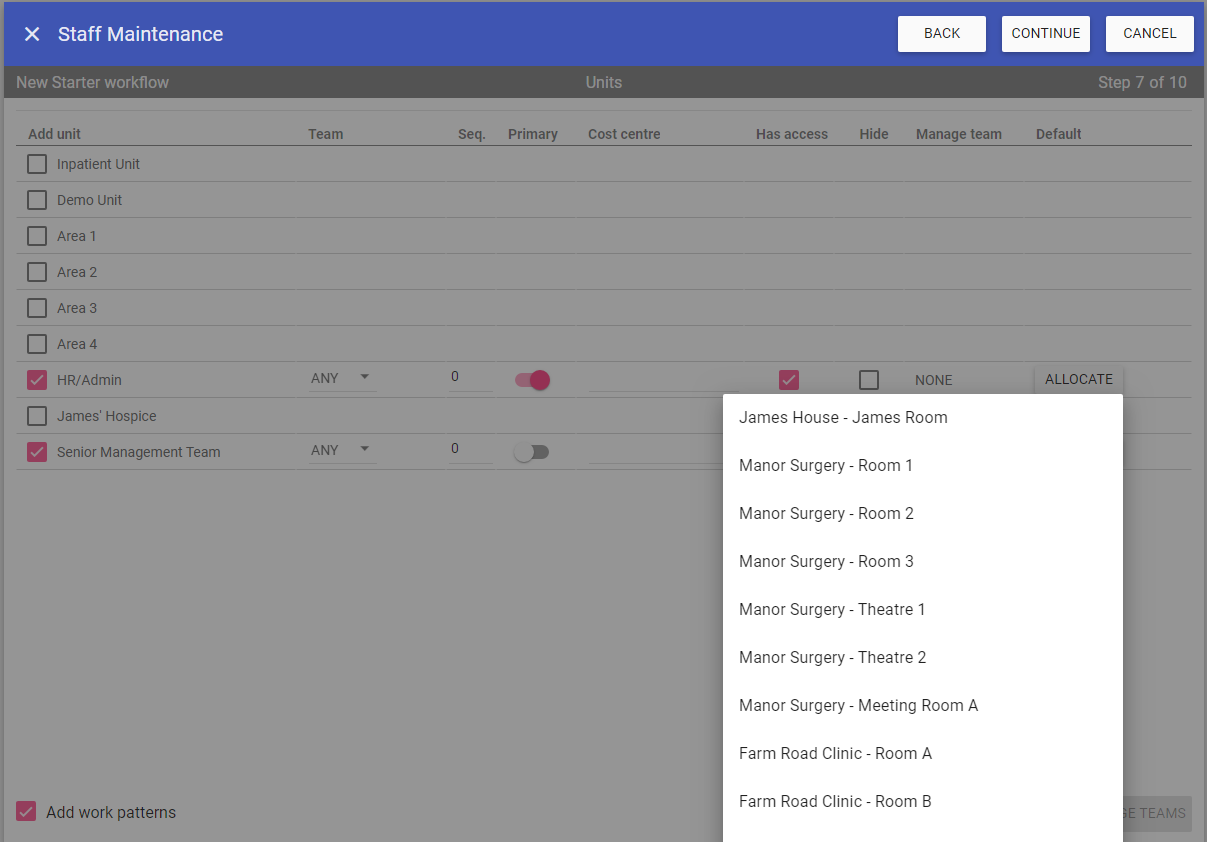 And the room name will appear in the Default column, you can also edit the default allocation by selecting the pen icon alongside the room name:
And the room name will appear in the Default column, you can also edit the default allocation by selecting the pen icon alongside the room name:
 Step 8 is Work Patterns.
Step 8 is Work Patterns.
On this screen you can add a working pattern for the shifts the staff member will do:
![]() The information icon shows how to copy the shifts across.
The information icon shows how to copy the shifts across.
 Step 9 is associating staff leaves, this screen is in the same format as the units. Simply ticking a leave will add it to the staff member’s record.
Step 9 is associating staff leaves, this screen is in the same format as the units. Simply ticking a leave will add it to the staff member’s record.
NOTE: Any leaves with any of the Leave accruals formulae set will display a calculator icon.
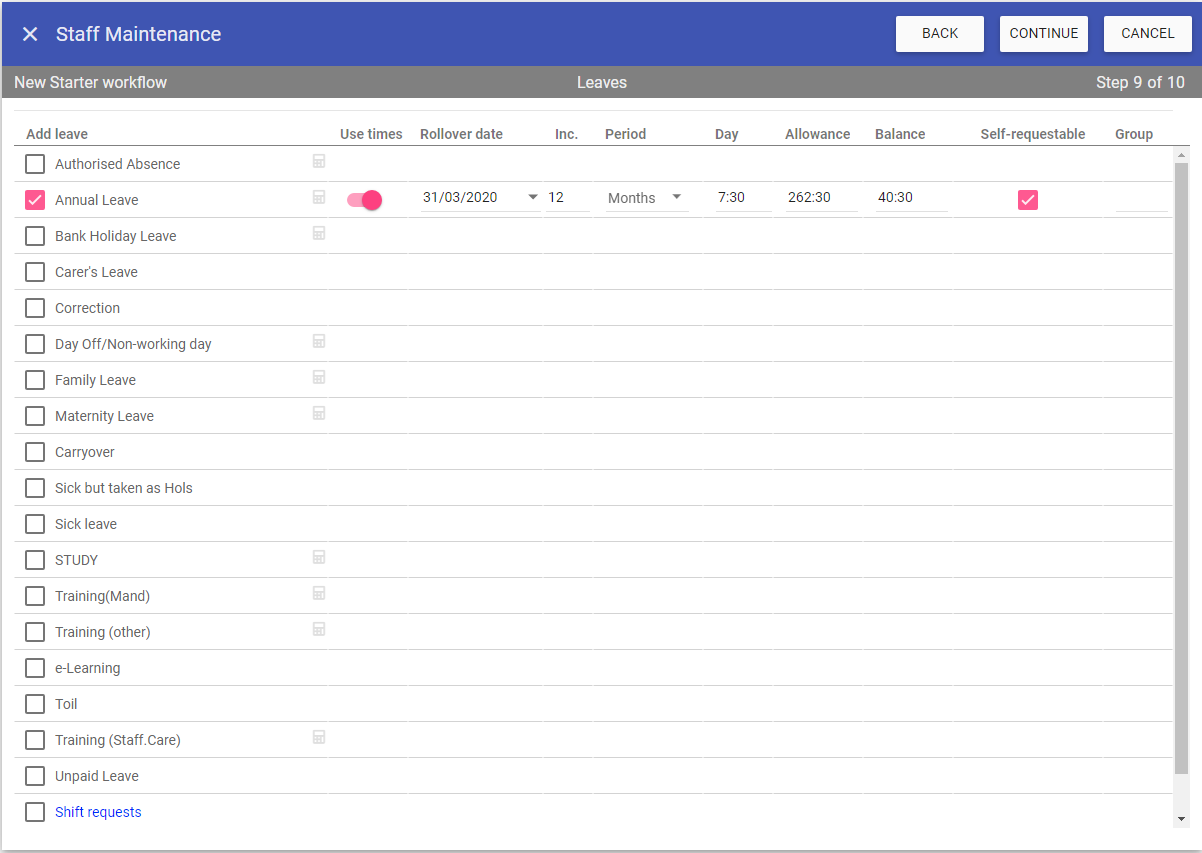 Step 10 is the last step: The contract summary.
Step 10 is the last step: The contract summary.
The contract summary shows the important information from the contract setup including the staff member who completed the contract and when.
NOTE: The summary is always available to view and print in Staff Maintenance within the
Contracts tab.
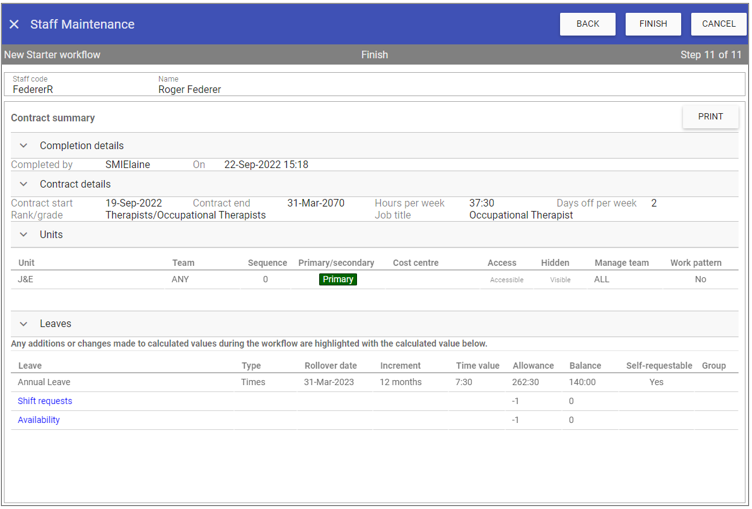 Upon clicking finish the new starter is added to Staff.Care and you are taken to the main Staff Maintenance screen ready to add the next one.
Upon clicking finish the new starter is added to Staff.Care and you are taken to the main Staff Maintenance screen ready to add the next one.
Contract Workflows
In order to add a new contract to a staff member, simply open their staff maintenance record, navigate to the Contracts tab and click New
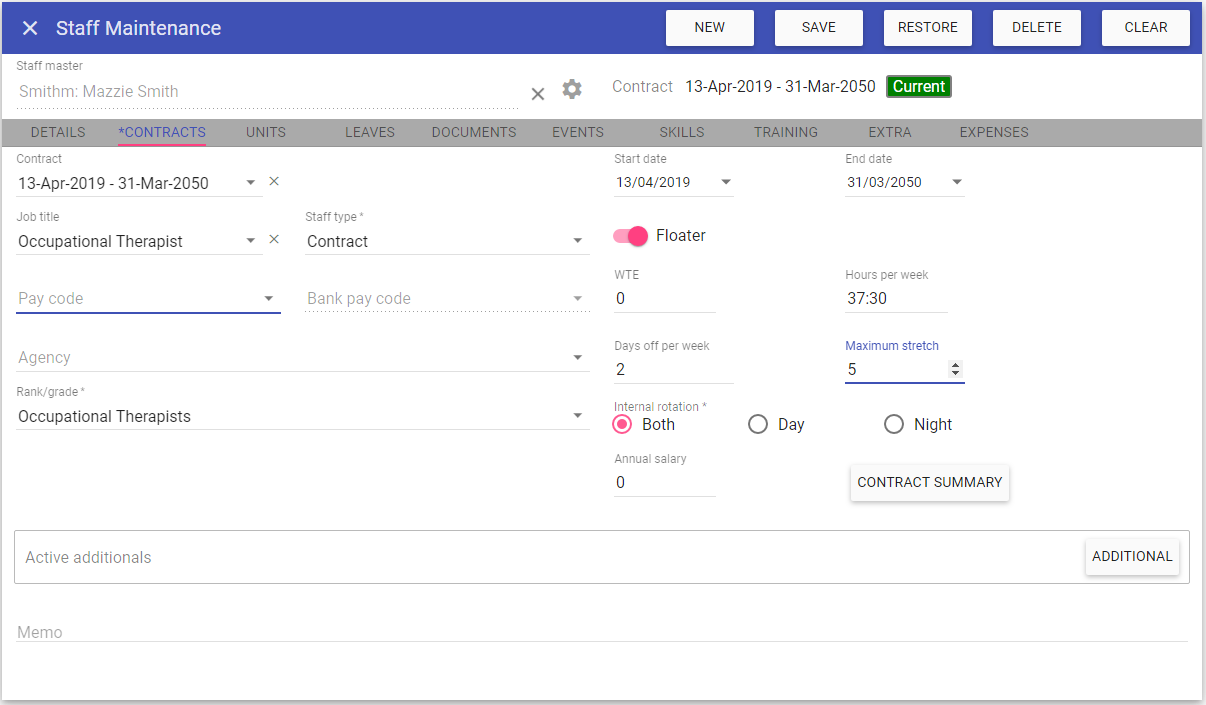
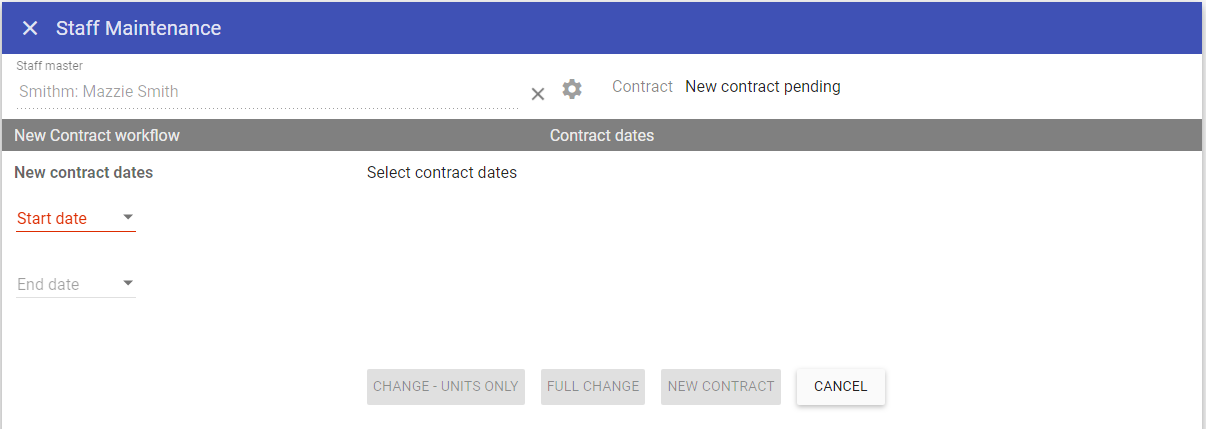 The new contracts workflow covers:
The new contracts workflow covers:
New Contract: Where no pre-existing contract is present (or after the existing contract finishes).
Change - Units Only: Where the new contract starts part way through an existing contract and you only want to change their units.
Full Change: Where the new contract starts part way through an existing contract and you want to change more than just their units.
New Contract Only
The options presented depends on the start date of the new contract, if it doesn’t overlap a pre-existing contract then you can add a new contract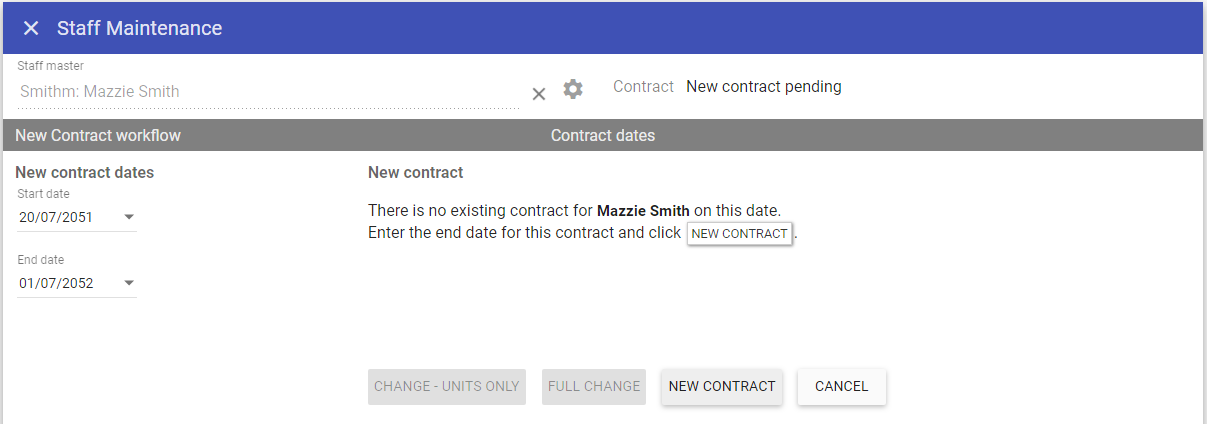 In the next screen you can choose whether or not to copy details from an old contract by selecting the contract from the dropdown, and choosing which information to copy.
In the next screen you can choose whether or not to copy details from an old contract by selecting the contract from the dropdown, and choosing which information to copy.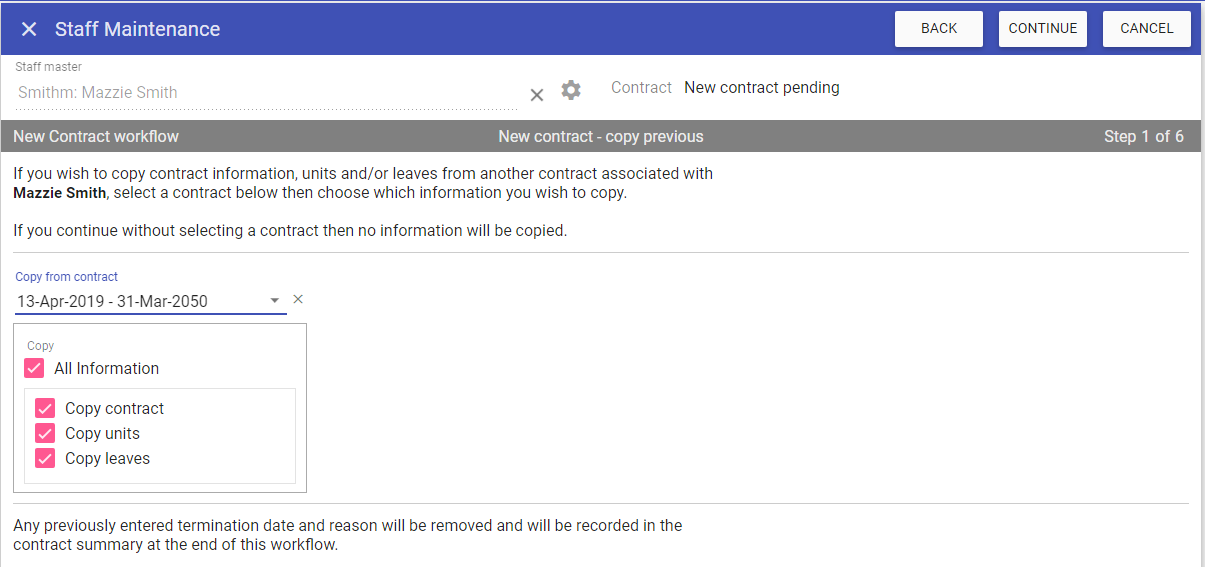 NOTE: If the staff member had previously left, the termination date and reason would be removed during this workflow.
NOTE: If the staff member had previously left, the termination date and reason would be removed during this workflow.Copying the information from all tabs means it is already there and you can make adjustments as appropriate to the contract, units and leaves without having to start from scratch.
The workflow will now take you through:
• Contract tab.
• Units tab with team management where appropriate – if the units that the contract you chose are no longer used (hidden) these will not be selected during the copy.
• Work patterns (if required).
• Default room allocation (if required).
• Alerts.
• Leaves tab – all the rollover dates will be updated to those pertinent to the new contract.
These tabs are all detailed above in the New Starter Workflow. Again at the end, once completed, you will be able to view and print the contract summary from the new contract.
Units Only
Upon entering a start date in the new contract workflow which overlaps a pre-existing contract you are prompted with the contract change dialogue and only have the option to either complete a units only or a full change.
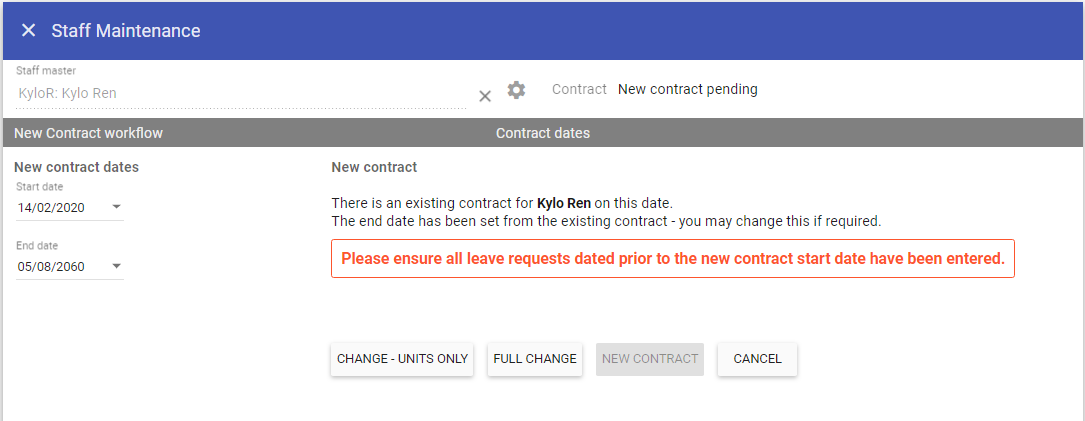 NOTE: Part of the change process moves all leave balance to the new contract, so if you do not enter all the leaves dated before the new contract starts
(08/02/2019 or before in the above example), you will not be able to after finishing the contract change.
NOTE: Part of the change process moves all leave balance to the new contract, so if you do not enter all the leaves dated before the new contract starts
(08/02/2019 or before in the above example), you will not be able to after finishing the contract change.
REMEMBER: You cannot complete a contract change retrospectively after you have completed the leave rollover.
Clicking CHANGE – UNITS ONLY – will start the simplified contract change workflow where only units can be changed. In the units grid the current units will be displayed.
You can make your changes and click CONTINUE.
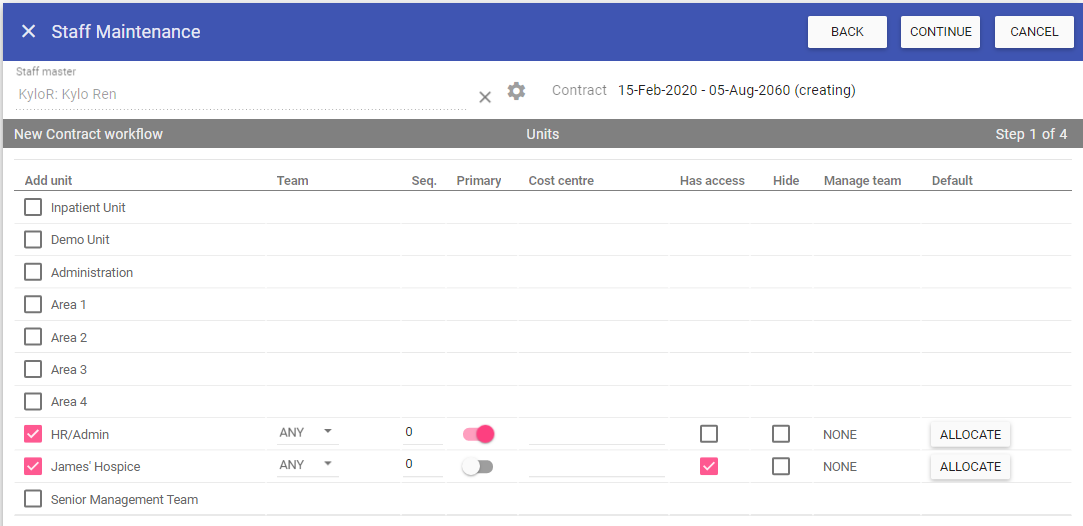 NOTE: you can complete team management setup and assign working patterns during this workflow too.
NOTE: you can complete team management setup and assign working patterns during this workflow too.
Upon clicking Continue you are presented with the Alerts screen where changes can be made. By Clicking Continue again you can view the list of affected shifts/leaves.
 Any shifts that cannot be completed on the new contract will be deleted, you can also choose to refuse any leaves, change the leave time values or delete any other shifts as required.
Any shifts that cannot be completed on the new contract will be deleted, you can also choose to refuse any leaves, change the leave time values or delete any other shifts as required.
The leaves are colour coded into rollover periods. Green is the current rollover period and grey is all future rollover periods.
NOTE: Leave is shown in Episodes making time value changes easier to implement.
Upon clicking
CONTINUE the final step is the summary where the workflow can be completed.
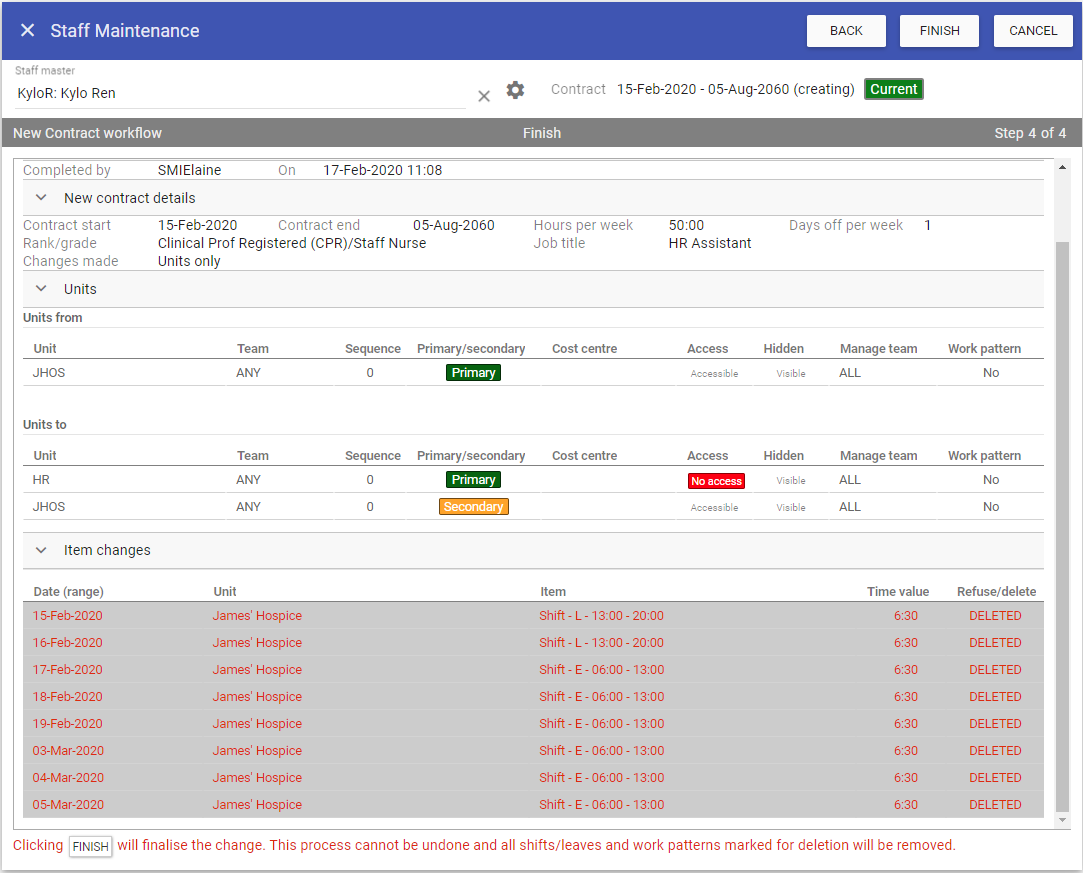 Clicking FINISH will complete the workflow and save the new contract into Staff.Care. Any refused/deleted shifts/leaves will be removed.
Clicking FINISH will complete the workflow and save the new contract into Staff.Care. Any refused/deleted shifts/leaves will be removed.
Full Contract Change
In order to start the full contract change workflow, upon entering the start date click FULL CHANGE.
In the copy contract screen the previous contract is chosen, as this is the contract from which data will be transferred.
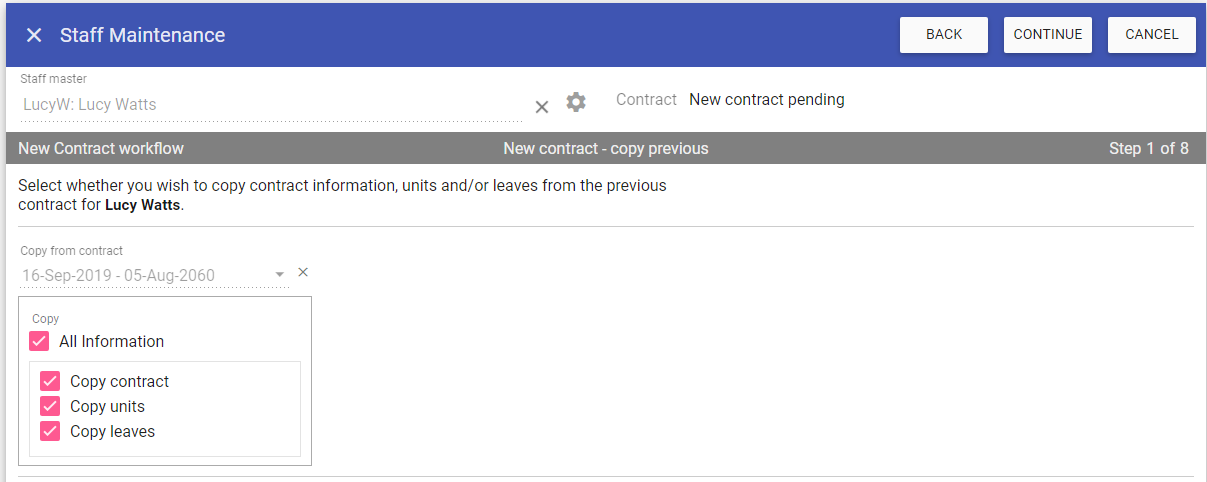 NOTE: You can choose not to copy certain information across, however, SMI recommend you copy everything forward unless the staff member is moving from contract to bank or bank to contract.
NOTE: You can choose not to copy certain information across, however, SMI recommend you copy everything forward unless the staff member is moving from contract to bank or bank to contract.
REMEMBER: You cannot copy leaves to a new contract with a start date prior to the last completed leave rollover.
Upon clicking continue you are presented with the contract screen, here you can make your amendments to the contract.
In this example the staff member is reducing their hours to 30:00 per week and increasing their days off per week to 3 to accommodate this change.
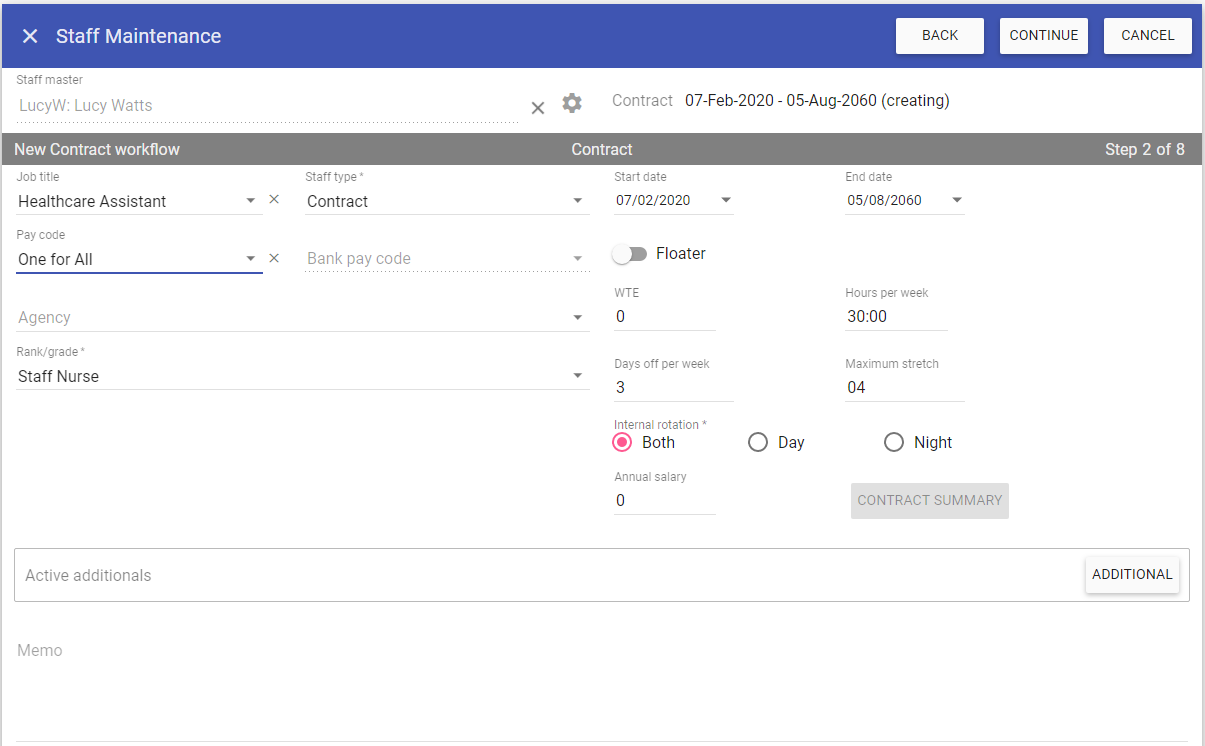 The next step allows you to change units or add additional units if required.
The next step allows you to change units or add additional units if required.
NOTE: Work patterns are selected by default, as where these exist a change in contract will more than likely change the shifts they will be working.
The work patterns screen shows an excess of
10 hours as we have reduced contracted hours.
 You will not be able to continue where the work pattern exceeds contract hours.
You will not be able to continue where the work pattern exceeds contract hours.
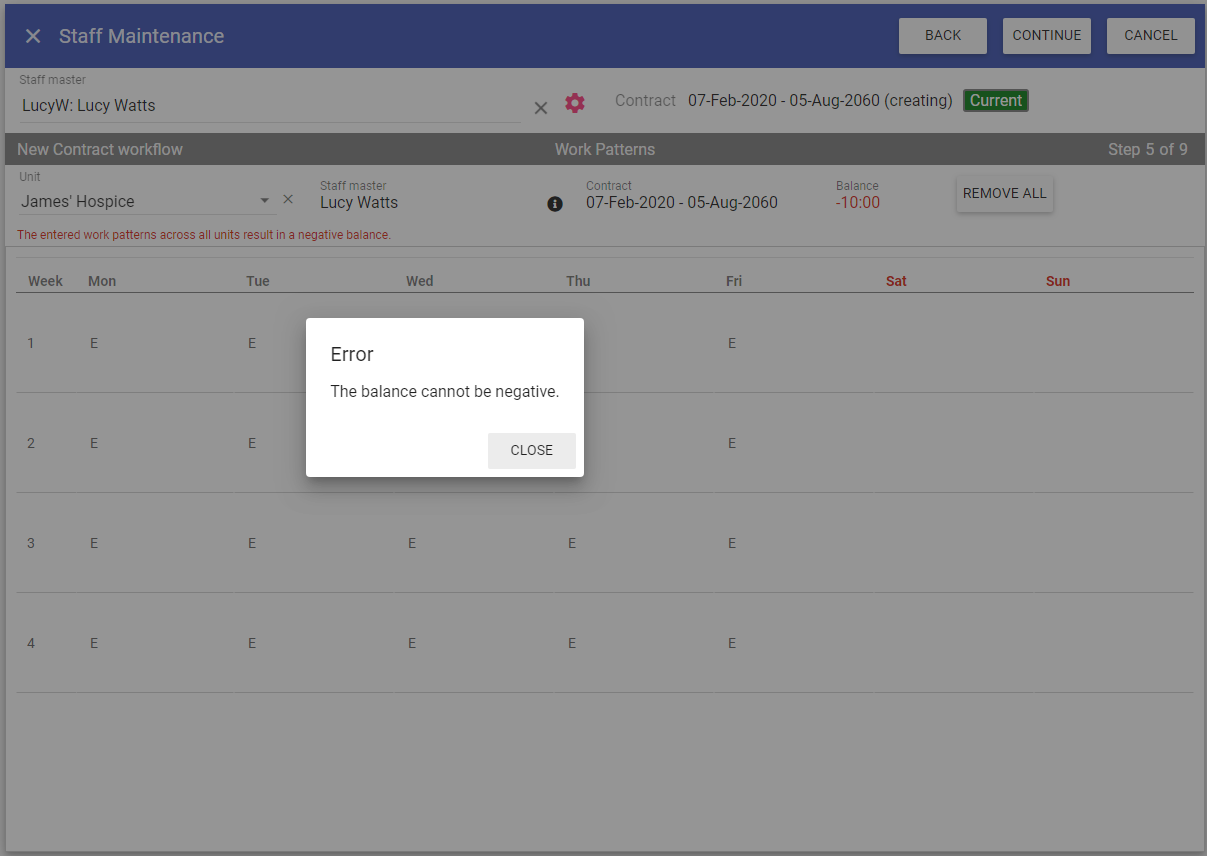 Once you have updated the working pattern so the balance is 0:00 or above, you can continue.
Once you have updated the working pattern so the balance is 0:00 or above, you can continue.
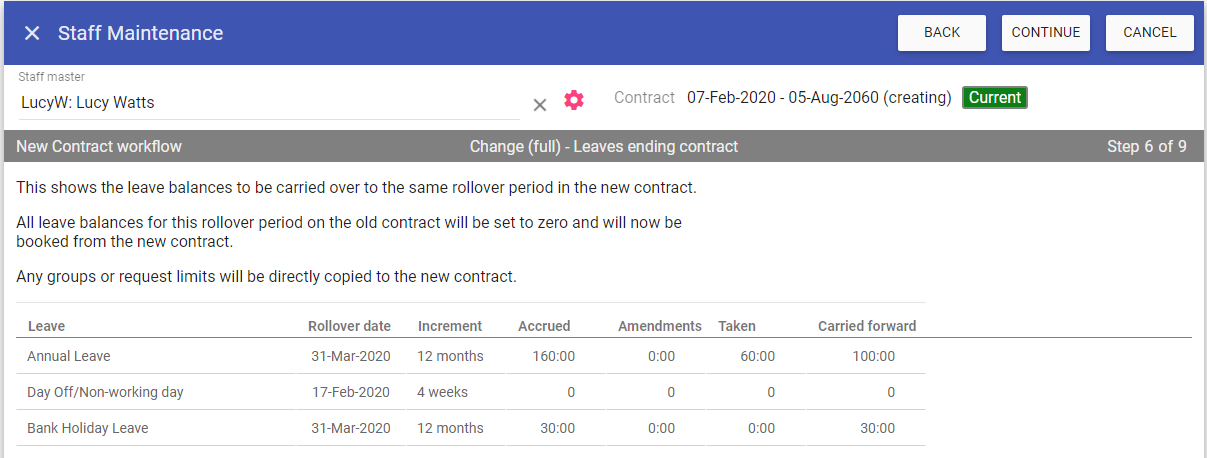 The Leave accrual calculations are applied here for the ending of a contract.
The Leave accrual calculations are applied here for the ending of a contract.
Rollover date: This applies the next rollover date after the new contract starts.
Increment: Shows the increment set to each leave type.
Accrued: This is the calculated leave accrual for the ending contract in this rollover period.
Amendments: This is the total additions or reductions to balance in the shown rollover period.
Taken: This shows the total leave of each type taken during the rollover period.
Carried forward: Allows you to edit amounts carried forward from previous year if required (this can be positive or negative).
Clicking CONTINUE takes us to the new contract leaves screen.
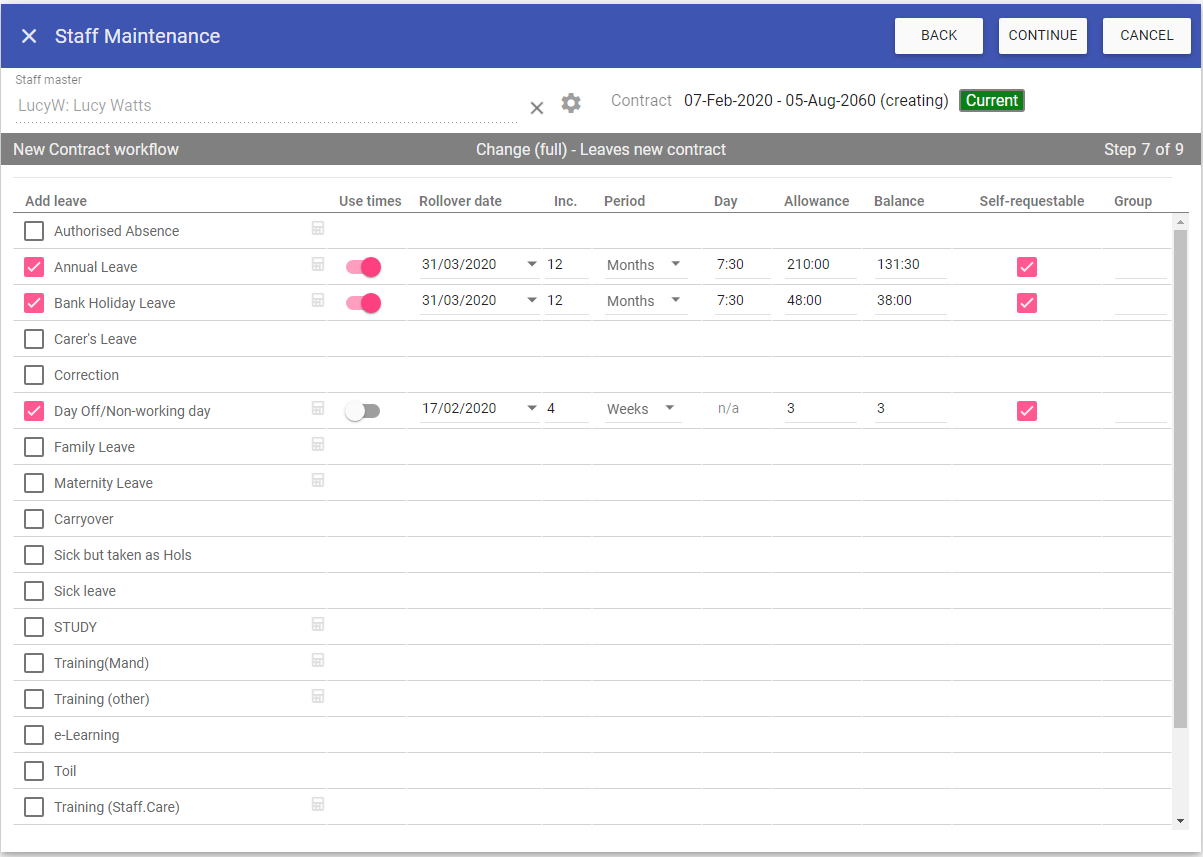 The leave accrual calculations are completed here and include the leave carried forward plus any leave booked in the remainder of the displayed rollover period.
The leave accrual calculations are completed here and include the leave carried forward plus any leave booked in the remainder of the displayed rollover period.
NOTE: If your change occurs in the next rollover period then no leave is carried forward.
Upon clicking CONTINUE you will be taken to the changes screen – this includes any leaves or shifts which are dated after the change.
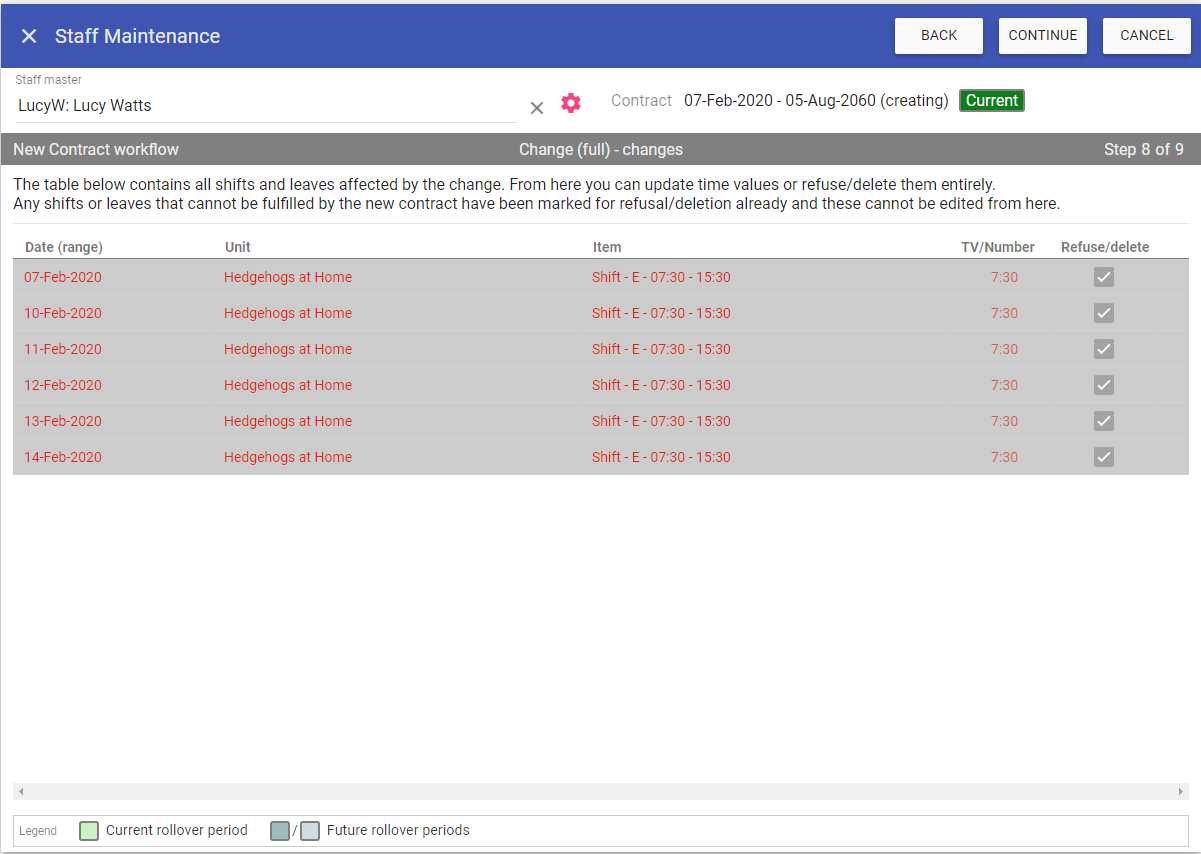 Where leave is over booked in a rollover period the exclamation icon will be displayed and on hover-over this will tell you how much over they are.
Where leave is over booked in a rollover period the exclamation icon will be displayed and on hover-over this will tell you how much over they are.
You can refuse these here or leave them to carry the negative balance forward meaning that the organisation will never be out of pocket.
NOTE: As we know you cannot always refuse booked leaves, this process will allow leave balances to be negative.
REMEMBER: Negative balances will ALWAYS be carried forward to the next rollover period.
You can also adjust time value leave balances manually if you wish by clicking on the balance and entering a time value.
NOTE: Any changes to leave balances or refusing leave will be taken into consideration in the final balance.
As this staff member is reducing hours you can also delete shifts from rotas to bring their working hours in-line with their new contract.
Upon completing your changes and clicking CONTINUE you are presented with the contract summary which saves against the new contract.
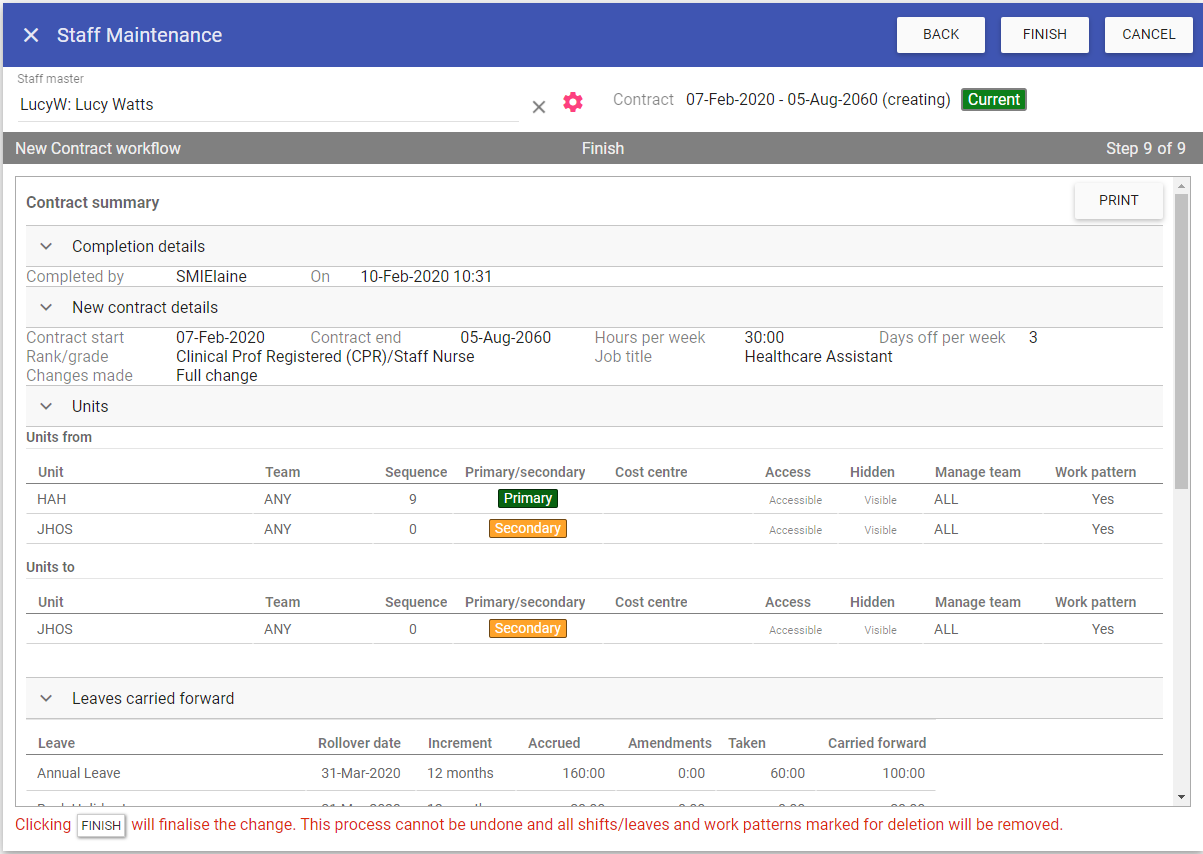 Click FINISH to complete all changes.
Click FINISH to complete all changes.
If you don't add a default room to a staff member during any of the contract workflows, you can do this retrospectively by clicking on the unit under the Units tab
and then open up the drop-down box alongside Default allocation:
 Once the room is selected it will appear under the Default allocation column:
Once the room is selected it will appear under the Default allocation column:

Items - Documents/Events/Skills/Training/Staff Extras
All items of the same type have a single row view, showing the first start date and the latest end date of consecutive/overlapping entries (these are denoted by 3 red dots after the start date): Clicking on the entry here will bring up the latest of each item:
Clicking on the entry here will bring up the latest of each item: Selecting Show history within the list will show all entries individually, with the latest end date at the top:
Selecting Show history within the list will show all entries individually, with the latest end date at the top: The Ignore expiry control, which is present within each item, stops the selected event from outputting to the Items Management dashboard when it is
expiring/expired (there is also a filter to remove these from all 4 of the items reports). Perfect for when staff change roles and no longer require certain items to be updated:
The Ignore expiry control, which is present within each item, stops the selected event from outputting to the Items Management dashboard when it is
expiring/expired (there is also a filter to remove these from all 4 of the items reports). Perfect for when staff change roles and no longer require certain items to be updated:
 All documents, including their acknowledgement status are also displayed in
Staff Maintenance:
All documents, including their acknowledgement status are also displayed in
Staff Maintenance: